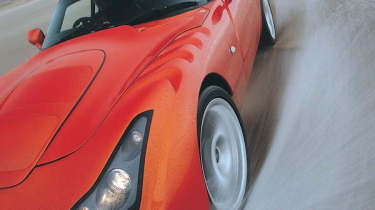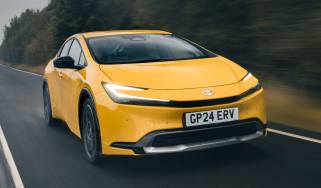TVR Sagaris
With its wild vents and 406bhp straight-six, Sagaris is the extreme new face of TVR
It's been a long time since I've driven anything that turns heads like a TVR Sagaris. Any trip through town has jaws dropping, necks of either sex swivelling, and any number of small, tanktop-clad boys making circling motions with their hands. How did they know for sure that a TVR Sagaris can so easily fill the road with smoke? There aren't many cars that will really light up the rear wheels from 20mph just by planting the right foot, with absolutely no need to dump the clutch. No doubt about it, the Sagaris has an ability to advertise its presence in no uncertain manner - even when stationary - and in that respect it's like a lot of TVRs in recent times. Just a lot more so. TVR's line-up is a little confusing these days but the Sagaris is intended to be the 'hero road- racer' of the T350 series, a line-up that includes the Tamora convertible, T350C coupe and T350T targa. (The Tuscan series is also owed a 'hero' derivative, the carbonfibre-bodied supercharged Typhon, due at the end of the year.) Although the Sagaris bears a strong resemblance to the T350C, it no longer shares any body panels (the concept car first shown in November 2003 did), and there are numerous other significant detail changes to give it the edge on trackdays and to make it simple to convert it into a full-on race car. Sagaris production was due to start in the middle of last year, but when Nikolai Smolenski took over TVR he stalled the car's launch to embark on a more thorough quality programme than had previously been the norm at Blackpool. The Sagaris is a mixture of Star Wars prop, computer game graphic, deep sea Crustacean and Le Mans GT warrior, a combination that is undeniably striking yet not so completely off the wall as to seem contrived. Look a little harder, though, and you begin to see some method in the madness. The splitter that sticks out like a bottom lip below the grille, complete with winglets, is the kind you'd find on a pukka GT race car and so is the roof vent above the driver's head (although that opens on the race version only). The swathe of bonnet vents and the Perspex Gurney flap across the boot are pure race prototype, as is the undertray that cradles the twin, sideways-mounted and side-exiting silencers and tailpipes. The Sagaris is intended to be an extreme, track-biased machine and much of the aerodynamic tweaking is a consequence of experience gained with TVR's Le Mans project. The reason its styling looks so well resolved is perhaps down to the designers being involved in the aerodynamic development which, for the first time at TVR, included wind tunnel sessions. Nevertheless there has been a bit of backtracking in the styling department since the car was first rolled out. The bonnet is well vented to expel the air from above the splitter and to aid cooling but for the road car the slats in the wing-tops are stylistic garnishes and not really vents at all; they'll revert to full functionality for the race version, but the sight of muddy water cascading from the top of these vents was deemed too hardcore and unseemly for road use. The rear valance originally stuck out much further and cradled the silencers, and has now been pulled into the bodywork, while the way-out rear lights have been replaced by more conventional items - by TVR standards, that is. Underneath all this gappy glassfibre is the traditional TVR spaceframe, a double-deck ladder backbone structure made of large- diameter tubes with outriggers onto which the body is mounted. It's traditional technology in an age of carbonfibre and spot-welded steel, but TVR's argument is that its backbone set-up has all the required torsional stiffness and is far lighter than slicing off the top of a steel monocoque and then having to reinforce the resulting structure. TVR also reckons that its lengthy experience with mat and resins and the combination of triangulated tubes and glassfibre, laid up around a central core, provides exceptional energy absorption in a shunt; it might surprise you to learn that during the Type Approval crash tests for the Tuscan, which has a very similar layout, many of the occupant injury criteria were 'significantly below the permitted limits' without recourse to airbags. The Sagaris is also light; TVR claims 1078kg, considerably less than most 400bhp cars. Despite the plethora of models and drivetrains that TVR seems to wheel out for every motor show, there's a fair bit of big-manufacturer commonality in the company's chassis department. With the exception of the four-seat Cerbera, where it was four inches longer, the chassis underneath all modern TVRs has been almost identical in dimension and specification - including the original Griffith and the race Tuscan. The Sagaris's main structure is similar but slightly wider at the front and rear suspension pick-up points in order to create some extra track for the racers. A glance inside the cabin reveals a remarkably unobtrusive full roll-cage, which is tightly fitted to the roof and rear load area and is neatly trimmed. Suspension is time-honoured TVR with double wishbones at each end and coil-over dampers, and the differential comes with a slipper. The engine is the laid-over, TVR-developed 4-litre, 24-valve twin-cam 'Speed Six' that's good for 406bhp between 7000-7500rpm and 349lb ft of torque at 5000rpm. It's allied to a veteran Borg-Warner T5 five-speed gearbox originally produced for the Ford Mustang in the 1980s and still man enough for the Blackpool muscle-car. Back inside the cabin you see the now familiar TVR styling and construction cues, like the racer's pedals, all three machined from the solid, sprouting up from the floor like Stalagmites, and the central tunnel with its 'flying squirrel' covering. Designer Graham Browne says that bit was inspired by the way the guy cables for the Millennium Dome stretch the canvas. You'd need to see it... There are the now-traditional curvy bits on the dash and tunnel but slightly fewer of the Tuscan's fluted aluminium knobs and quirky controls. Windows are still operated by two buttons - one up, one down - and the doors by one button each side. That, of course, keeps the inside of the doors free of any knobs or switches and provides an opportunity for more scooping and swooping, all of it weaved and wefted in fibre. Lights and heater controls are still fluty to the touch, their position indicated by a row of LEDs, and although they seem fiddly at first, it soon becomes intuitive - not least because most of them can be twiddled with the fingertips without taking your hands off the wheel. At least the indicator and wiper stalks operate conventionally and there's an ignition key rather than a button... TVR is clearly turning sensible. Or not. Twist the key, let the long needles for the tacho and speedo do their little wake-up dance around the dials before settling down to business, press the immobiliser to make the fuel pumps thrum and whirr, and crank it up. The first thing you notice - as well as the rattle of pre-ignition as the engine catches - is the speed of response to the accelerator. It's something that emissions regulations have largely blunted in most ranges but TVR has spent a lot of time ensuring its engines behave traditionally yet comply with modern regs. Second thing you'll notice is the rich variety of sounds coming from the exhausts. Prod the pedal and there's a muffled, breathy growl that sounds as if there's too much gas trying to get out, overlaid as the revs and load build by a flatulent rasp. It makes for a seductive aural cocktail and will cause you to crank down the window the better to listen to TVR's irreverent disregard of political correctness. Clutch and pedals turn out to be easier to use than the Tuscan's and the driving position is almost perfect, both of which could be down to the wider chassis and body. The steering wheel is a conventional aftermarket Personal with normal width spokes and just a pair of buttons on the back for the digital display below the main dials - something you need to be a computer enthusiast to operate. I'm not sure whether it's my memory playing tricks or whether this T5 'box is a happy combination of tolerances, but the gearshift feels lighter and easier to use than in any previous TVR; once you have just a modest amount of warmth in the engine and transmission, the Sagaris is easy to drive around town. Leave the limit behind and find your favourite piece of twisty road and you'll soon discover the Sagaris's ride is uncompromisingly firm, the front end's response to the steering extremely sharp. It's not quite the fractious thing that the first Tuscan was, but it still demands a relaxed pair of hands; tense up too much when the Sagaris sniffs out a ridge in the road to follow and you're probably going to have a fight on your hands. And yet once you begin to relax and trust the car, it becomes less intimidating. So don't pile into a turn, stand the car on its nose and heave the wheel, because it'll only mean you have more to unravel as you get into the bend, during which time you will have used up all of your available roadspace and more. Instead, brake a little earlier but take a touch of extra speed toward the apex and squeeze and ease the rim rather than turn it. At sane speeds the Sagaris will then track round the corner free of understeer. The way you can lean on the nose - even tighten the line, then tighten it again without any of that that scrubby feeling from the tyres - is very commanding and something you rarely find without the benefit of wings and slick tyres. A settled entry to the corner also guards against oversteer, of which more in a moment, and although the mechanical and aerodynamic reasons are completely different, the Sagaris is a bit like the powerful 1960s GTs that inspired it. If you don't provoke it in the first place, you can enjoy a whole lot more of what it has to offer. The nervy feeling has turned to something quite seductive. On the track, though, it's less resolved, which is something of an irony. Here you instinctively want to be putting in a bit more effort and commitment but when you do so the Sagaris seems to become pointier still. Quicker corners suck the car in with such alacrity that you often find yourself sorting out the moment very early in the turn. At first I wondered whether the prodigious speed delivered by the wonderful, growling, farting six was simply even bigger than it subjectively feels and whether I was doing what I'd learn not to do on the road, which is find myself in the corner still going too fast, but the settled technique didn't seem to work any better. If you let the tail slide you can balance it with some power and then the sharp steering makes it easier to manage than it might be, but it needs care and it's quite hard work. Slower corners are nothing like as busy, so my guess is that all those wingy bits are pushing the nose ever harder to the road the faster you go, and there isn't the racer's rubber and massively stiff springing to cope with it. That said, a razor-sharp front end is a much harder thing to create than it is to moderate, so if you wanted a different balance, I don't think it would be hard to find. The engine, meanwhile, is great, pulling all the way through a massively wide power band. It seems to keep on gathering speed for ever in each gear. It's not quite as smooth or revvy as its smaller 3.6-litre brother, but it manages to be gruffly vintage in a way a BMW would never want to be. Yet it also demonstrates a complete lack of temperament, a refinement for which we have modern electronics to thank. Meanwhile, the brakes, which had seemed a touch firm and lifeless at road speeds, now have a real tireless bite and you get the feeling that the car would withstand a trackday and still get you home with pad-wear to spare. The Sagaris is very focused in the same way that the Porsche 911 GT3RS is and reveals some similar compromises in ride and response when you come to use it on the road. But then you can't help noticing that the TVR is half the price of the Porsche... The Sagaris isn't perfect. We experienced a number of niggling build quality issues, which we weren't expecting under the new regime. But it's as massively exciting to drive as it is to look at. In an age when outrage and thrill are an increasingly rare automotive combination, it's gratifying to report that it remains one of TVR's greatest and most attractive strengths.
Comparison
| TVR Sagaris | |
| Engine | In-line 6-cyl |
| Location | Front-mid, longitudinal |
| Displacement | 3996cc |
| Cylinder Block | Aluminium alloy |
| Cylinder Head | Aluminium alloy, dohc, four valves per cylinder |
| Fuel and Ignition | Integrated engine management multipoint fuel injection, port throttles |
| Max Power | 406bhp @ 7500rpm |
| Max Torque | 349lb ft @ 5000rpm |
| Transmission | Borg Warner five-speed manual, Hydratrak limited-slip differential, rear-wheel drive |
| Front Suspension | Double wishbones, coil-over gas dampers, anti-roll bar |
| Rear Suspension | Double wishbones, coil-over gas dampers, anti-roll bar |
| Brakes | Ventilated discs all-round, 322mm front, 298mm rear |
| Wheels | 8.5J x 18in |
| Tyres | 255/35 R18, Goodyear Eagle F1 |
| Weight Kerb | 1078kg |
| Power to Weight | 383bhp per ton |
| Max Speed | 185mph+ (claimed) |
| Basic Price | £49,995 |
| On Sale | Now |
| Rating | 4 |
| 0 to 60 MPH | 3.7sec (claimed) |



